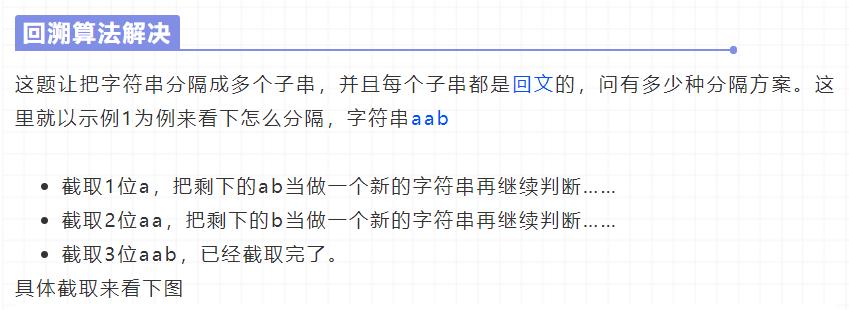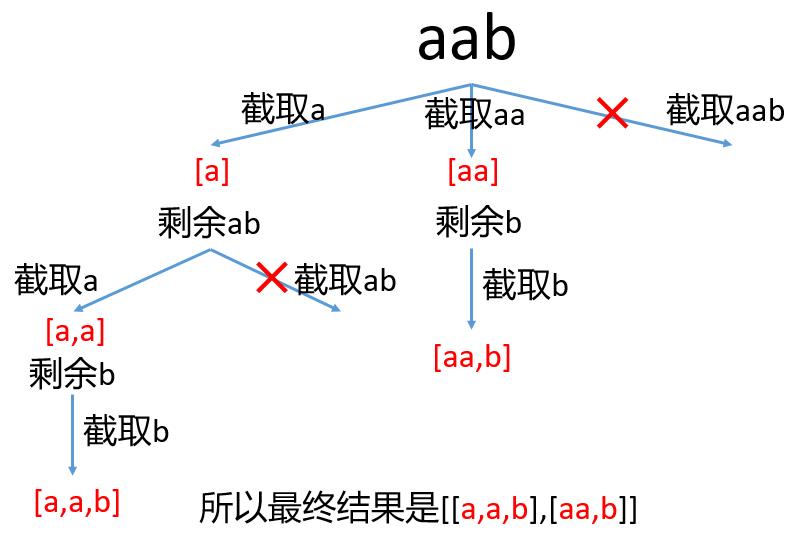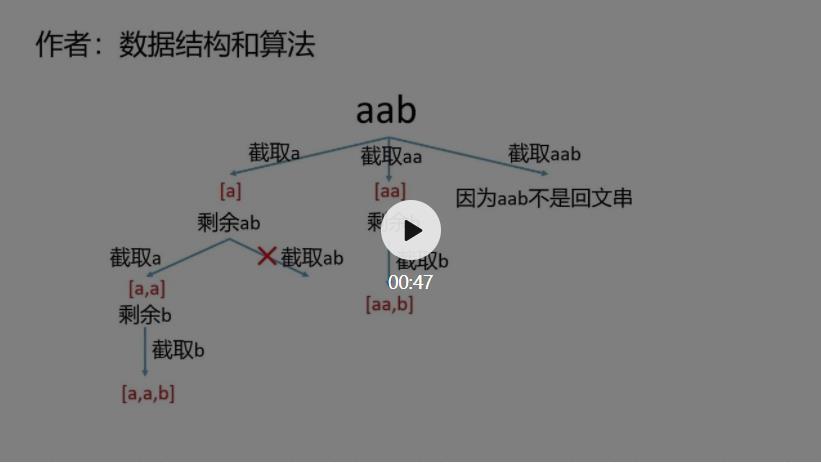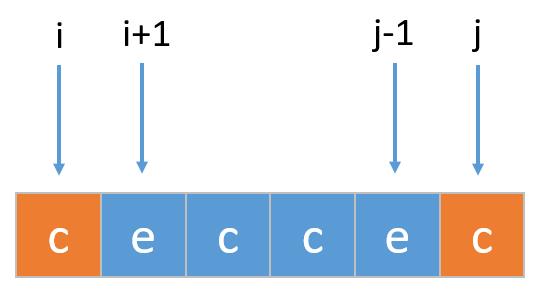LeetCode 131. 分割回文串
Posted 数据结构和算法
tags:
篇首语:本文由小常识网(cha138.com)小编为大家整理,主要介绍了LeetCode 131. 分割回文串相关的知识,希望对你有一定的参考价值。
截止到目前我已经写了 500多道算法题,其中部分已经整理成了pdf文档,目前总共有1000多页(并且还会不断的增加),大家可以免费下载
下载链接:https://pan.baidu.com/s/1hjwK0ZeRxYGB8lIkbKuQgQ
提取码:6666



来看下视频演示

一看就知道,其实就是个n叉树的DFS遍历,从根节点到叶子节点是字符串s截取的子串,我们只需要判断这些子串是否都是回文串即可,只要有一个不是就可以直接终止,如果从根节点到叶子节点的每个子串都是回文串,说明我们找到了一组截取方案。
但这题让把截取的结果返回,所以我们很容易想到的就是使用回溯算法解决,关于回溯算法不明白的可以看下《450,什么叫回溯算法,一看就会,一写就废》,大致代码如下
/**
* @param s 就是需要截取的字符串
* @param index 字符串开始截取的位置
* @param res 最终的分隔方案结果
* @param cur 沿着当前分支截取的子串
*/
public void backTrack(String s, int index, List<List<String>> res, List<String> cur) {
//边界条件判断,如果字符串s中的字符都访问完了(类似于到叶子节点了),就停止查找,
//然后这个分支的所有元素加入到集合res中
if (index >= s.length()) {
res.add(new ArrayList<>(cur));
return;
}
for (int i = index; i < s.length(); i++) {
//如果当前截取的子串不是回文的,就跳过
if (!isPalindrome(s, index, i))
continue;
//做出选择,开始截取,把截取的子串放到集合cur中
cur.add(s.substring(index, i + 1));
//递归,到下一层(类似于到n叉树的子节点去遍历)
backTrack(s, i + 1, res, cur);
//撤销选择,就是把之前截取放到集合cur中的子串给移除掉
cur.remove(cur.size() - 1);
}
}
搞懂了上面的分析过程,我们再来看下最终代码
public List<List<String>> partition(String s) {
//最终要返回的结果
List<List<String>> res = new ArrayList<>();
backTrack(s, 0, res, new ArrayList<>());
return res;
}
public void backTrack(String s, int index, List<List<String>> res, List<String> cur) {
//边界条件判断,如果字符串s中的字符都访问完了(类似于到叶子节点了),就停止查找,
//然后这个分支的所有元素加入到集合res中
if (index >= s.length()) {
res.add(new ArrayList<>(cur));
return;
}
for (int i = index; i < s.length(); i++) {
//如果当前截取的子串不是回文的,就跳过
if (!isPalindrome(s, index, i))
continue;
//做出选择
cur.add(s.substring(index, i + 1));
//递归
backTrack(s, i + 1, res, cur);
//撤销选择
cur.remove(cur.size() - 1);
}
}
//判断字符串从[left,right]的子串是否是回文的
public boolean isPalindrome(String str, int left, int right) {
while (left < right) {
if (str.charAt(left++) != str.charAt(right--))
return false;
}
return true;
}

//数组dp[i][j]表示字符串s下标[i,j]的子串是否是回文的
boolean[][] dp = new boolean[length][length];
for (int i = 0; i < length; i++) {
for (int j = 0; j <= i; j++) {
if (s.charAt(i) == s.charAt(j) && (i - j <= 2 || dp[j + 1][i - 1])) {
dp[j][i] = true;
}
}
}
不懂的可以看下《540,动态规划和中心扩散法解回文子串》,这里就不在重复介绍

再来看下最终代码
public List<List<String>> partition(String s) {
//最终要返回的结果
List<List<String>> res = new ArrayList<>();
int length = s.length();
//下面先计算子串中哪些是回文的,哪些不是
//数组dp[i][j]表示字符串s下标[i,j]的子串是否是回文的
boolean[][] dp = new boolean[length][length];
for (int i = 0; i < length; i++) {
for (int j = 0; j <= i; j++) {
if (s.charAt(i) == s.charAt(j) && (i - j <= 2 || dp[j + 1][i - 1])) {
dp[j][i] = true;
}
}
}
backTrack(s, dp, 0, res, new ArrayList<>());
return res;
}
public void backTrack(String s, boolean[][] dp, int index, List<List<String>> res, List<String> cur) {
//边界条件判断,如果字符串s中的字符都访问完了(类似于到叶子节点了),就停止查找,
//然后这个分支的所有元素加入到集合res中
if (index >= s.length()) {
res.add(new ArrayList<>(cur));
return;
}
for (int i = index; i < s.length(); i++) {
//如果当前截取的子串不是回文的,就跳过
if (!dp[index][i])
continue;
//做出选择
cur.add(s.substring(index, i + 1));
//递归
backTrack(s, dp, i + 1, res, cur);
//撤销选择
cur.remove(cur.size() - 1);
}
}
回溯算法其实是有一个经典的模板的,掌握这个模板,很多关于回溯算法的题套用模板然后稍加修改基本上都能解决,关于模板可以看下《450,什么叫回溯算法,一看就会,一写就废》,总结一下就是3步
- 做出选择
- 递归到下一层
- 撤销选择
以上是关于LeetCode 131. 分割回文串的主要内容,如果未能解决你的问题,请参考以下文章